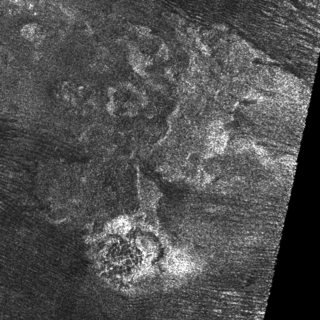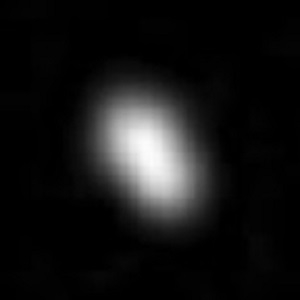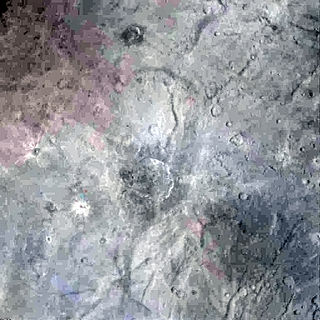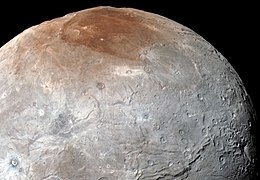
Pluto is a dwarf planet in the Kuiper belt, a ring of bodies beyond the orbit of Neptune. It was the first object discovered in the Kuiper belt and remains the largest known body in that area. After Pluto was discovered in 1930, it was declared the ninth planet from the Sun. However, beginning in the 1990s, its status as a planet was questioned following the discovery of several objects of similar size in the Kuiper belt and the scattered disc, including the dwarf planet Eris, leading the International Astronomical Union (IAU) in 2006 to define the term planet formally—excluding Pluto and reclassifying it as a dwarf planet.

Charon, known as (134340) Pluto I, is the largest of the five known natural satellites of the dwarf planet Pluto. It has a mean radius of 606 km (377 mi). Charon is the sixth-largest known trans-Neptunian object after Pluto, Eris, Haumea, Makemake and Gonggong. It was discovered in 1978 at the United States Naval Observatory in Washington, D.C., using photographic plates taken at the United States Naval Observatory Flagstaff Station (NOFS).

A minor-planet moon is an astronomical object that orbits a minor planet as its natural satellite. As of January 2022, there are 457 minor planets known or suspected to have moons. Discoveries of minor-planet moons are important because the determination of their orbits provides estimates on the mass and density of the primary, allowing insights of their physical properties that is generally not otherwise possible.

James Walter "Jim" Christy is an American astronomer known for discovering Charon, the largest moon of the dwarf planet Pluto.

A cryovolcano is a type of volcano that erupts volatiles such as water, ammonia or methane into an extremely cold environment that is at or below their freezing point. The process of formation is known as cryovolcanism. Collectively referred to as cryomagma, cryolava or ice-volcanic melt, these substances are usually liquids and can form plumes, but can also be in vapour form. After the eruption, cryomagma is expected to condense to a solid form when exposed to the very low surrounding temperature. Cryovolcanoes may potentially form on icy moons and other objects with abundant water past the Solar System's snow line. A number of features have been identified as possible cryovolcanoes on Pluto, Titan and Ceres, and a subset of domes on Europa may have cryovolcanic origins. In addition, although they are not known to form volcanoes, ice geysers have been observed on Enceladus and potentially Triton.

Nix is a natural satellite of Pluto, with a diameter of 49.8 km (30.9 mi) across its longest dimension. It was discovered along with Pluto's outermost moon Hydra on 15 May 2005 by astronomers using the Hubble Space Telescope, and was named after Nyx, the Greek goddess of the night. Nix is the third moon of Pluto by distance, orbiting between the moons Styx and Kerberos.

Hydra is a natural satellite of Pluto, with a diameter of approximately 51 km (32 mi) across its longest dimension. It is the second-largest moon of Pluto, being slightly larger than Nix. Hydra was discovered along with Nix by astronomers using the Hubble Space Telescope on 15 May 2005, and was named after the Hydra, the nine-headed underworld serpent in Greek mythology. By distance, Hydra is the fifth and outermost moon of Pluto, orbiting beyond Pluto's fourth moon Kerberos.

The dwarf planet Pluto has five natural satellites. In order of distance from Pluto, they are Charon, Styx, Nix, Kerberos, and Hydra. Charon, the largest, is mutually tidally locked with Pluto, and is massive enough that Pluto–Charon is sometimes considered a double dwarf planet.

A dwarf planet is a small planetary-mass object that is in direct orbit of the Sun – something smaller than any of the eight classical planets, but still a world in its own right. The prototypical dwarf planet is Pluto. The interest of dwarf planets to planetary geologists is that, being possibly differentiated and geologically active bodies, they may display planetary geology, an expectation borne out by the Dawn mission to Ceres and the New Horizons mission to Pluto in 2015.

Styx is a small natural satellite of Pluto whose discovery was announced on 11 July 2012. It was discovered by use of the Hubble Space Telescope. As of 2022, it is the smallest known moon of Pluto. It was imaged along with Pluto and Pluto's other moons by the New Horizons spacecraft in July 2015, albeit poorly with only a single image of Styx obtained.

Cthulhu Macula is a prominent surface feature of the dwarf planet Pluto, that is reminiscent of a whale in shape. It is an elongated dark region along Pluto's equator, 2,990 km (1,860 mi) long and one of the darkest features on Pluto. It is west of the Sputnik Planitia region of Tombaugh Regio, also known as Pluto's "heart", and to the east of Meng-P'o, the easternmost of Pluto's "Brass Knuckles".

The geology of Charon are the characteristics of the surface, crust, and interior of Pluto's moon Charon. Charon's diameter is 1,208 km (751 mi)—just over half that of Pluto. Charon is sufficiently massive to have collapsed into a spheroid under its own gravity.

Ripley is the unofficial name given to an impact crater on Pluto's moon Charon. It is named after the heroine Ellen Ripley in the science-fiction/horror film Alien.

Vulcan Planum is the unofficial name given to a large plain on the surface of Pluto's moon Charon, discovered by New Horizons during its flyby of Pluto in July 2015. It is named after the fictional planet Vulcan in the science-fiction series Star Trek. The name is not approved by International Astronomical Union, as of 2020.

Kirk Crater is the unofficial name given to a small crater on Pluto's largest moon Charon. The crater was discovered by the New Horizons space probe in 2015 during its flyby of Pluto and its moons. It was named after captain James T. Kirk from the Star Trek franchise and TV series. The crater is located in the southern hemisphere, just south of the equator, and just east of the prime meridian, near Clarke Montes, in a region that astronomers have named Vulcan Planum.

Vader is the unofficial name given to a dark crater on Pluto's largest moon Charon. The crater was discovered by NASA's New Horizons space probe on its way by Pluto. It was named after Darth Vader from the Star Wars media franchise.

Organa is the informal name given to a crater on Pluto's largest moon, Charon. The crater was discovered by NASA's New Horizons space probe on its flyby of Pluto. The name was chosen as a reference to Leia Organa from the Star Wars media franchise in the theme of naming Charon's craters after science fiction characters. Organa crater is rich in frozen ammonia, which suggests it was created very recently. This crater is located in the northern Pluto-facing hemisphere of Charon.

Nasreddin is a crater on Pluto's largest moon, Charon. The crater was first observed by NASA's New Horizons space probe on its flyby of Pluto in 2015. The name was chosen as a reference to Nasreddin, the hero of humorous folktales told throughout the Middle East, Southern Europe, and parts of Asia.


















